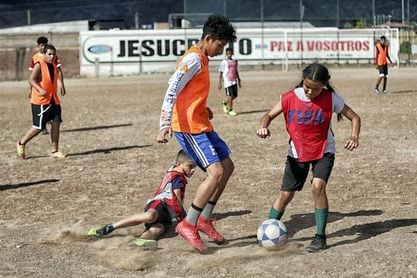Tegucigalpa, Feb 28 (EFE).- An irregular dirt field for practicing soccer, the king of Honduras, is like a silent witness to the many good players who walked behind the ball and went on to excel in the best teams, and the national teams of the Central American nation.
“César Obando, who has become the most technical player Honduras has ever had, comes off the dirt field of La Laguna,” coach Raúl Ochoa, who for 20 years has volunteered to lead several children’s and women’s teams in densely populated San Miguel. Honduras capital neighborhood.
Obando has hung up his boots, but his splendid form remains in the eyes of those who saw the fine midfielder play for club Motagua, from Tegucigalpa and the Honduras national team.
The pitch on which Ochoa coaches the boys is dirt, without grass, which is common in most of the country’s main cities due to the lack of support that football receives, despite the fact it is Honduras’ favorite sport. .
Even so, football is at the same time the sport with the most support compared to the 31 other sports organized by the Honduran Olympic Committee (COH), according to its president, Salvador Jiménez.
HOW MUCH TO PLAY FOOTBALL?
There are officially no records of how many Hondurans play football, but it is known that each of the 10 teams in the first division league has at least 30 players.
Another similar number was added to the 28 Liga de Ascenso clubs, spokesman for the National Autonomous Football Federation of Honduras (Fenafuth), Edwin Banegas, told Efe.
Including players from the Major League (third division) and other minor leagues, Banegas estimates the number to be around 55,000. To be sure, football in Honduras is played by the majority of children and adults of the Central American country’s 9.5 million population.
Until a few years ago, in Tegucigalpa alone, about 15,000 boys and girls practiced the sport through the Soccer for Life Programme, sponsored by the Tegucigalpa Mayor’s Office in a poor neighborhood of the city, playing on dirt courts.
The program was directed by Héctor ‘Pecho de guila’ Zelaya, World Cup player and goalscorer for Honduras in Spain 1982.
Zelaya told Efe that the program, which in its first four years depended on the National Sports Facilities Commission (Conapid), was divided into two categories, one with children aged 8 to 12 and the other aged 13 to 18.
“The ball is a means to attract children’s interest, they are required to attend school or college, to participate in social activities in their environment and they are provided with, among other things, assistance, medical brigades and dental services,” he added.
THE BEST COMES FROM THE NORTH
For Raúl Ochoa, the best players in the country come from the northern zone, as there are better pitches there, partly due to the plains and the great rivers that cross them.
According to him, there are many differences between those who play football on dirt courts and those who do it on grass.
“We’ve met kids who come to me from the north coast, who are very fast, very agile, solve problems very quickly, whereas those from the dirt courts are very technical, but they find it difficult to develop” that is, to be faster , he explained. .
Ochoa is a business administrator who, because of his love for football, trained as a Physical Education graduate from Francisco Morazán National Pedagogical University.
Better training for children and youth, according to Ochoa, is to train them on both types of courts, thereby improving their technique and playing speed.
“The technique, the agility to get away from three or four players is given to us by the clay court, the grass court allows us to be faster, more agile, more skilled at hitting the ball, that’s the difference”, he explained.
Ochoa starts her work at 2 p.m. with boys and girls in the categories between 7, 9, 11, 13 and 15 years.
He works in the public sector with a flexible schedule to be able to coach children with whom he also seeks to train them to be “more than football players, good people, with discipline, determination and courage”.
Moreover, he instills in his students that “learning is always in the first place”.
EXAMPLES TO FOLLOW
Several figures from the local team and even the senior team came off the field in the San Miguel neighborhood, recalls Ochoa.
Fredixon Elvir, Joham Barrientos and Omar Elvir, the latter one of the best left-backs at the moment, are some notable examples.
Among the rarity stands out a children’s team led by one of his brothers who usually beat their rivals every Sunday by a margin of up to ten goals.
But when he decides to coach the team at his brother’s request, his luck changes. Despite reaching the final, they lost 11-10 in a lengthy penalty shoot-out.
The Honduran Olympic Committee calculated that ideally sports would generally allocate 3% of the state budget, as was the case in Guatemala.
The new Honduras international is striker Alberth Elis, from France’s Girondins de Bordeaux.
Having an idol is good.
On the pitch in the San Miguel neighborhood, many of the boys Ochoa directed wanted to be Alberth Elis, even defenders.
Reyes German Germany

“Amateur analyst. Zombie geek. Hardcore troublemaker. Internet expert. Incurable twitter fanatic.”




:quality(70)/cloudfront-eu-central-1.images.arcpublishing.com/mentormedier/NBEATS6T3BJJH7K3BNTFA7RH5Q.jpg)
